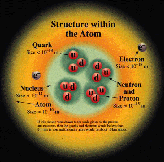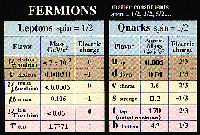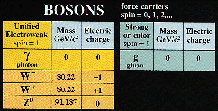

 Larger
(115k, gif)
Larger (72k, jpg)
Larger
(115k, gif)
Larger (72k, jpg)
The text of the figure reads:
If the protons and neutrons in this picture were 10 cm across, then the
quarks and electrons would be less than 0.1 mm in size and the
entire atom would be about 10 km across.
Spin is the intrinsic angular momentum of particles. Spin is given in units of h-bar, which is the quantum unit of angular momentum, where hbar=h/2pi = 6.58*10^-25 GeV s = 1.05*10^-34 J s.
Electric charges are given in units of the proton's charge. In SI units the electric charge of the proton is 1.60 * 10^-19 coulombs.
The energy unit of particle physics is the electron volt (eV), the energy gained by one electron in crossing a potential difference of one volt. Masses are given in GeV/c^2. (Remember E = mc^2 ), where 1 GeV = 10^9 eV = 1.60 * 10^-10 joule. The mass of the proton is 0.938 GeV/c^2 = 1.67*10^-27 kg
 Larger (78k, gif)
Larger (87k, jpg)
Larger (78k, gif)
Larger (87k, jpg)
Top quark discovered (Fermilab news release)
 Larger (66k, gif)
Larger (55k, jpg)
Larger (66k, gif)
Larger (55k, jpg)
 Larger (29k, gif)
Larger (27k, jpg)
Larger (29k, gif)
Larger (27k, jpg)
 Larger
(32k, gif)
Larger (25k, jpg)
Larger
(32k, gif)
Larger (25k, jpg)
 Larger
(52k, gif)
Larger (39k, jpg)
Larger
(52k, gif)
Larger (39k, jpg)
These diagrams are an artist's conception of physical processes. They are not exact and have no meaningful scale. Green shaded areas represent the cloud of gluons or the gluon field, red lines the quark paths, and black lines the paths of leptons.
 Larger
(26k, gif)
Larger (19k, jpg)
Larger
(26k, gif)
Larger (19k, jpg)
The text of the figure reads: A neutron decays to a proton,
an electron, and an antinuetrino via a virtual (mediating) W
boson. This is neutron beta decay.
 Larger
(29k, gif)
Larger (22k, jpg)
Larger
(29k, gif)
Larger (22k, jpg)
The text of the figure reads:
An electron and positron (antielectron) colliding at high energy
can annihilate to produce D+ and D- mesons via a virtual Z boson
or a virtual photon.
 Larger (33k, gif)
Larger (22k, jpg)
Larger (33k, gif)
Larger (22k, jpg)
The text of the figure reads:
The c and cbar quarks in an eta_c meson annihilate into virtual gluons.
Quark pair production in the gluon cloud sometimes gives a pi+, K0,
and K- as the final products.
The chart is copyrighted in 1995 by CPEP.
Copyrights and disclaimers and other funding
Betty Armstrong 21-JULY-1995